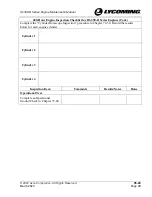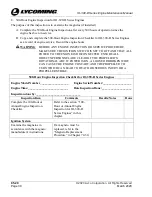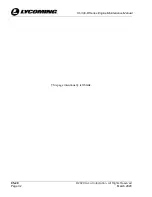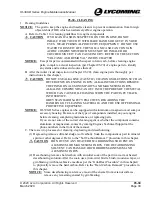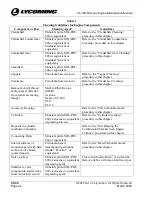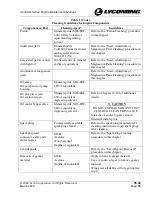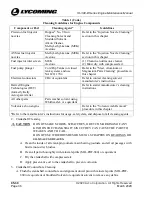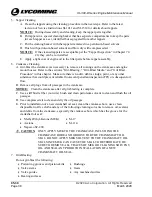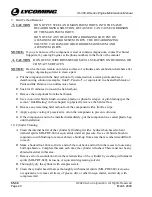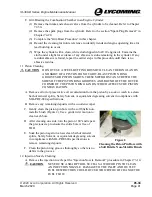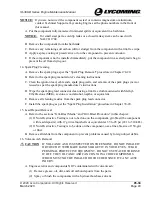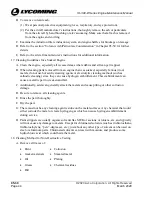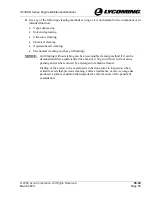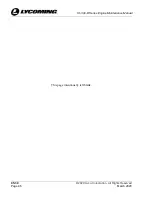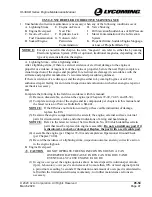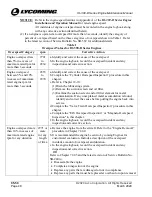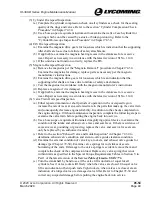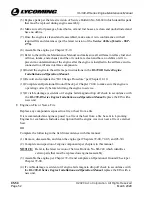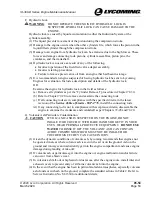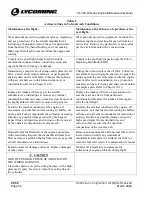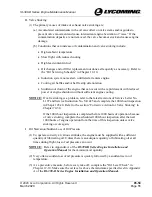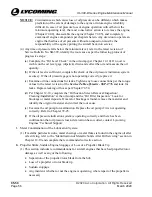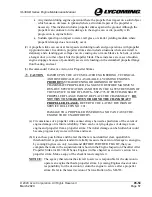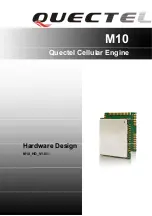
IO-390-D Series Engine Maintenance Manual
© 2020 Avco Corporation. All Rights Reserved
05-30
March 2020
Page 43
IO-390-D Series Engine Maintenance Manual
NOTICE:
If you are not sure if the component is steel or contains magnesium or aluminum,
contact Technical Support at Lycoming Engines at the phone numbers in the front of
this manual.
A.
Put the component fully immersed in mineral spirits or equivalent in a bath tank.
NOTICE:
For small steel parts, cold dip tanks or a closed tank system can be used with
NALCO 1704.
B.
Remove the component from the bath tank.
C.
Remove any remaining soft carbon (dirt or sludge) from the component with a lint-free wipe.
D.
Apply a spray coating of preservative oil on the component to prevent corrosion.
E.
If the component is not be installed immediately, put the component in a sealed plastic bag to
prevent the oil from drying out.
14.
Spark Plug Cleaning
A.
Remove the spark plug as per the “Spark Plug Removal” procedure in Chapter 74-20.
B.
Refer to the spark plug manufacturer’s cleaning instructions.
C.
Clean the ignition lead, cable ends, spark plug walls, and ceramic of the spark plugs (new or
reused) as per the spark plug manufacturer’s instructions.
D.
Wipe the spark plug lead connector clean using a lint-free cloth moistened with Methyl-
Ethyl-Ketone (MEK), acetone, wood alcohol, naptha, or equivalent.
E.
Remove all cleaning residue from the spark plug lead connector.
F.
Install the spark plug as per the “Spark Plug Installation” procedure in Chapter 74-20.
15.
Lead Deposit Removal
A.
Refer to the sections “Grit-Blast Media” and “Grit-Blast Procedure” in this chapter:
(1)
If Non-Destructive Testing is not to be done on the component, grit-blast (the component
with lead deposits) with 17 grit walnut shells or equivalent at 35 to 45 psi (241 to 310 kPa).
(2)
If Non-Destructive Testing is to be done on the component, use a fine abrasive of 150-grit
or finer.
B.
Remove all debris from the component to prevent problems caused by foreign object debris.
16.
Volcanic Ash Removal
CAUTION
IF VOLCANIC ASH IS SUSPECTED ON THE ENGINE, DO NOT INHALE IT
OR TOUCH IT WITH BARE HANDS OR GET IT IN YOUR EYES. WEAR
PERSONAL PROTECTIVE EQUIPMENT. DO NOT USE WATER TO RINSE
IT OFF. THE VOLCANIC ASH CAN CONTAIN ACIDIC COMPOUNDS
WHICH MUST NOT BE INHALED OR TOUCHED SINCE IT CAN CAUSE
INJURY.
A.
Engine exterior and components NOT contaminated with volcanic ash:
(1)
Remove grease, oil, dirt, and soft carbon deposits from the parts.
(2)
Spray or brush the components with a hydrocarbon-base solvent.

